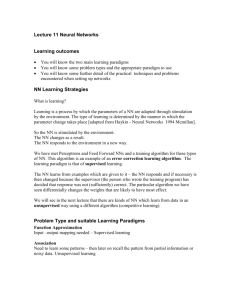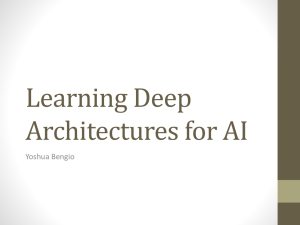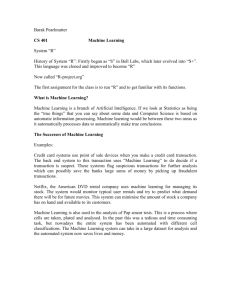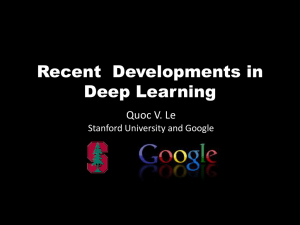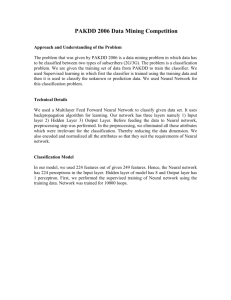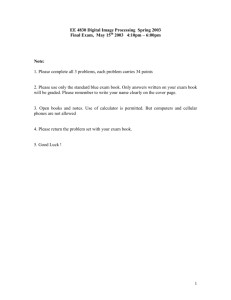Deep Learning for Vision - Stanford AI Lab
advertisement
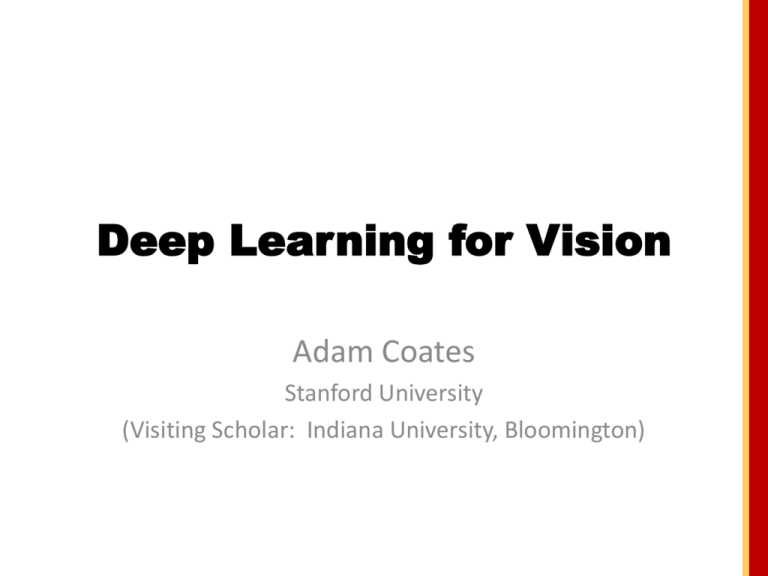
Deep Learning for Vision
Adam Coates
Stanford University
(Visiting Scholar: Indiana University, Bloomington)
What do we want ML to do?
• Given image, predict complex high-level patterns:
“Cat”
Object recognition
Detection
Segmentation
[Martin et al., 2001]
2
How is ML done?
• Machine learning often uses common pipeline with
hand-designed feature extraction.
• Final ML algorithm learns to make decisions starting from
the higher-level representation.
• Sometimes layers of increasingly high-level abstractions.
– Constructed using prior knowledge about problem domain.
Feature Extraction
3
Prior Knowledge,
Experience
Machine Learning
Algorithm
“Cat”?
“Deep Learning”
• Deep Learning
• Train multiple layers of features/abstractions from data.
• Try to discover representation that makes decisions easy.
More abstract representation
Low-level
Features
4
Mid-level
Features
High-level
Features
Classifier
Deep Learning: train layers of features so that classifier works well.
“Cat”?
“Deep Learning”
• Why do we want “deep learning”?
– Some decisions require many stages of processing.
• Easy to invent cases where a “deep” model is compact but a
shallow model is very large / inefficient.
– We already, intuitively, hand-engineer “layers” of
representation.
• Let’s replace this with something automated!
– Algorithms scale well with data and computing power.
• In practice, one of the most consistently successful ways to
get good results in ML.
• Can try to take advantage of unlabeled data to learn
representations before the task.
5
Have we been here before?
Yes.
– Basic ideas common to past ML and neural networks
research.
• Supervised learning is straight-forward.
• Standard ML development strategies still relevant.
• Some knowledge carried over from problem domains.
No.
– Faster computers; more data.
– Better optimizers; better initialization schemes.
• “Unsupervised pre-training” trick
[Hinton et al. 2006; Bengio et al. 2006]
– Lots of empirical evidence about what works.
• Made useful by ability to “mix and match” components.
[See, e.g., Jarrett et al., ICCV 2009]
6
Real impact
• DL systems are high performers in many tasks
over many domains.
[Honglak Lee]
Image recognition
[E.g., Krizhevsky et al., 2012]
7
NLP
Speech recognition
[E.g., Heigold et al., 2013] [E.g., Socher et al., ICML 2011;
Collobert & Weston, ICML 2008]
Outline
• ML refresher / crash course
– Logistic regression
– Optimization
– Features
• Supervised deep learning
– Neural network models
– Back-propagation
– Training procedures
• Supervised DL for images
– Neural network architectures for images.
– Application to Image-Net
8
• Debugging
• Unsupervised DL
• References / Resources
Outline
•
•
•
•
ML refresher / crash course
Supervised deep learning
Supervised DL for images
Debugging
• Unsupervised DL
–
–
–
–
Representation learning, unsupervised feature learning.
Greedy layer-wise training.
Example: sparse auto-encoders.
Other unsupervised learning algorithms.
• References / Resources
9
Crash Course
MACHINE LEARNING
REFRESHER
Supervised Learning
• Given labeled training examples:
• For instance: x(i) = vector of pixel intensities.
y(i) = object class ID.
255
98
93
87
…
f(x)
y = 1 (“Cat”)
• Goal: find f(x) to predict y from x on training data.
11
– Hopefully: learned predictor works on “test” data.
Logistic Regression
• Simple binary classification algorithm
– Start with a function of the form:
– Interpretation: f(x) is probability that y = 1.
• Sigmoid “nonlinearity” squashes linear function to [0,1].
1
– Find choice of
12
that minimizes objective:
Optimization
• How do we tune to minimize
• One algorithm: gradient descent
?
– Compute gradient:
– Follow gradient “downhill”:
• Stochastic Gradient Descent (SGD): take step
using gradient from only small batch of examples.
– Scales to larger datasets. [Bottou & LeCun, 2005]
13
Is this enough?
• Loss is convex we always find minimum.
• Works for simple problems:
– Classify digits as 0 or 1 using pixel intensity.
– Certain pixels are highly informative --- e.g., center pixel.
• Fails for even slightly harder problems.
– Is this a coffee mug?
14
Why is vision so hard?
“Coffee Mug”
Pixel Intensity
Pixel intensity is a very poor representation.
15
Why is vision so hard?
pixel 2
pixel 1
[72 160]
pixel 2
+
-
Pixel Intensity
-+
pixel 1
16
+
Coffee Mug
-
Not Coffee Mug
Why is vision so hard?
Is this a Coffee Mug?
pixel 2
+
+
--
+
pixel 2
+
+
- +-
Learning Algorithm
pixel 1
17
+
Coffee Mug
-
Not Coffee Mug
+
--
+
+
- +-
pixel 1
Features
cylinder?
handle?
Is this a Coffee Mug?
cylinder?
cylinder?
++
++
+
- -
18
Learning Algorithm
handle?
+
Coffee Mug
-
Not Coffee Mug
++
++
+
- -
handle?
Features
• Features are usually hard-wired
transformations built into the system.
– Formally, a function that maps raw input to a
“higher level” representation.
– Completely static --- so just substitute φ(x) for x and
do logistic regression like before.
Where do we get good features?
19
Features
• Huge investment devoted to building applicationspecific feature representations.
– Find higher-level patterns so that final decision is easy
to learn with ML algorithm.
Object Bank [Li et al., 2010]
SIFT [Lowe, 1999]
20
Super-pixels
[Gould et al., 2008; Ren & Malik, 2003]
Spin Images [Johnson & Hebert, 1999]
Extension to neural networks
SUPERVISED
DEEP LEARNING
Basic idea
• We saw how to do supervised learning when
the “features” φ(x) are fixed.
– Let’s extend to case where features are given by
tunable functions with their own parameters.
Outer part of function is same
as logistic regression.
22
Inputs are “features”---one
feature for each row of W:
Basic idea
• To do supervised learning for two-class
classification, minimize:
• Same as logistic regression, but now f(x) has
multiple stages (“layers”, “modules”):
23
Intermediate representation (“features”)
Prediction for
Neural network
• This model is a sigmoid “neural network”:
“Neuron”
Flow of computation.
“Forward prop”
24
Neural network
• Can stack up several layers:
25
Must learn multiple stages
of internal “representation”.
Back-propagation
• Minimize:
• To minimize
we need gradients:
– Then use gradient descent algorithm as before.
• Formula for
can be found by hand
(same as before); but what about W?
26
The Chain Rule
• Suppose we have a module that looks like:
• And we know
and
, chain rule gives:
Jacobian matrix.
Similarly for W:
27
Given gradient with respect to output, we can build a new
“module” that finds gradient with respect to inputs.
The Chain Rule
• Easy to build toolkit of known rules to compute
gradients given
– Automated differentiation! E.g., Theano [Bergstra et al., 2010]
Function
28
Gradient w.r.t. input
Gradient w.r.t. parameters
Back-propagation
• Can re-apply chain rule to get gradients for all
intermediate values and parameters.
“Backward” modules for each forward stage.
29
Example
• Given
, compute
:
Using several items from our table:
30
Training Procedure
• Collect labeled training data
– For SGD: Randomly shuffle after each epoch!
• For a batch of examples:
– Compute gradient w.r.t. all parameters in network.
– Make a small update to parameters.
– Repeat until convergence.
31
Training Procedure
• Historically, this has not worked so easily.
– Non-convex: Local minima; convergence criteria.
– Optimization becomes difficult with many stages.
• “Vanishing gradient problem”
– Hard to diagnose and debug malfunctions.
• Many things turn out to matter:
– Choice of nonlinearities.
– Initialization of parameters.
– Optimizer parameters: step size, schedule.
32
Nonlinearities
• Choice of functions inside network matters.
– Sigmoid function turns out to be difficult.
– Some other choices often used:
abs(z)
tanh(z)
1
1
ReLu(z) = max{0, z}
1
-1
“Rectified Linear Unit”
Increasingly popular.
33
[Nair & Hinton, 2010]
Initialization
• Usually small random values.
– Try to choose so that typical input to a neuron avoids saturating
/ non-differentiable areas.
1
– Occasionally inspect units for saturation / blowup.
– Larger values may give faster convergence, but worse models!
• Initialization schemes for particular units:
– tanh units: Unif[-r, r]; sigmoid: Unif[-4r, 4r].
See [Glorot et al., AISTATS 2010]
34
• Later in this tutorial: unsupervised pre-training.
Optimization: Step sizes
• Choose SGD step size carefully.
– Up to factor ~2 can make a difference.
• Strategies:
– Brute-force: try many; pick one with best result.
– Choose so that typical “update” to a weight is roughly 1/1000 times
weight magnitude. [Look at histograms.]
• Smaller if fan-in to neurons is large.
– Racing: pick size with best error on validation data after T steps.
• Not always accurate if T is too small.
• Step size schedule:
– Simple 1/t schedule:
– Or: fixed step size. But if little progress is made on objective after T
steps, cut step size in half.
Bengio, 2012: “Practical Recommendations for Gradient-Based Training of Deep Architectures”
Hinton, 2010: “A Practical Guide to Training Restricted Boltzmann Machines”
35
Optimization: Momentum
• “Smooth” estimate of gradient from several
steps of SGD:
• A little bit like second-order information.
– High-curvature directions cancel out.
– Low-curvature directions “add up” and accelerate.
Bengio, 2012: “Practical Recommendations for Gradient-Based Training of Deep Architectures”
Hinton, 2010: “A Practical Guide to Training Restricted Boltzmann Machines”
36
Optimization: Momentum
• “Smooth” estimate of gradient from several
steps of SGD:
– Start out with μ = 0.5; gradually increase to 0.9,
or 0.99 after learning is proceeding smoothly.
– Large momentum appears to help with hard
training tasks.
– “Nesterov accelerated gradient” is similar; yields
some improvement.
[Sutskever et al., ICML 2013]
37
Other factors
• “Weight decay” penalty can help.
– Add small penalty for squared weight magnitude.
• For modest datasets, LBFGS or second-order
methods are easier than SGD.
– See, e.g.: Martens & Sutskever, ICML 2011.
– Can crudely extend to mini-batch case if batches
are large. [Le et al., ICML 2011]
38
Application
SUPERVISED DL FOR
VISION
Working with images
• Major factors:
– Choose functional form of network to roughly match
the computations we need to represent.
• E.g., “selective” features and “invariant” features.
– Try to exploit knowledge of images to accelerate
training or improve performance.
• Generally try to avoid wiring detailed visual
knowledge into system --- prefer to learn.
40
Local connectivity
• Neural network view of single neuron:
Extremely large number of connections.
More parameters to train.
Higher computational expense.
Turn out not to be helpful in practice.
41
Local connectivity
• Reduce parameters with local connections.
– Weight vector is a spatially localized “filter”.
42
Local connectivity
• Sometimes think of neurons as viewing small
adjacent windows.
– Specify connectivity by the size (“receptive field” size)
and spacing (“step” or “stride”) of windows.
• Typical RF size = 5 to 20
• Typical step size = 1 pixel up to RF size.
Rows of W are sparse.
Only weights connecting to inputs
in the window are non-zero.
43
Local connectivity
• Spatial organization of filters means output features
can also be organized like an image.
– X,Y dimensions correspond to X,Y position of neuron
window.
– “Channels” are different features extracted from same
spatial location. (Also called “feature maps”, or “maps”.)
X spatial location
1-dimensional example:
“Channel” or “map” index
44
1D input
Local connectivity
We can treat output of a layer like an image and re-use the
same tricks.
X spatial location
“Channel” or “map” index
1-dimensional example:
45
1D input
Weight-Tying
• Even with local connections, may still have too
many weights.
– Trick: constrain some weights to be equal if we
know that some parts of input should learn same
kinds of features.
– Images tend to be “stationary”: different patches
tend to have similar low-level structure.
Constrain weights used at different spatial positions to
be the equal.
46
Weight-Tying
Before, could have neurons with different weights at different
locations. But can reduce parameters by making them equal.
X spatial location
1-dimensional example:
“Channel” or “map” index
1D input
• Sometimes called a “convolutional” network. Each unique
filter is spatially convolved with the input to produce
responses for each map.
[LeCun et al., 1989; LeCun et al., 2004]
47
Pooling
• Functional layers designed to represent invariant features.
• Usually locally connected with specific nonlinearities.
– Combined with convolution, corresponds to hard-wired
translation invariance.
• Usually fix weights to local box or gaussian filter.
– Easy to represent max-, average-, or 2-norm pooling.
48
[Scherer et al., ICANN 2010]
[Boureau et al., ICML 2010]
Contrast Normalization
• Empirically useful to soft-normalize magnitude of
groups of neurons.
– Sometimes we subtract out the local mean first.
49
[Jarrett et al., ICCV 2009]
Application: Image-Net
• System from Krizhevsky et al., NIPS 2012:
–
–
–
–
–
50
Convolutional neural network.
Max-pooling.
Rectified linear units (ReLu).
Contrast normalization.
Local connectivity.
Application: Image-Net
• Top result in LSVRC 2012: ~85%, Top-5 accuracy.
What’s an Agaric!?
51
More applications
• Segmentation: predict classes of pixels / super-pixels.
Farabet et al., ICML 2012
Ciresan et al., NIPS 2012
• Detection: combine classifiers with sliding-window architecture.
– Economical when used with convolutional nets.
Pierre Sermanet (2010)
• Robotic grasping. [Lenz et al., RSS 2013]
52
http://www.youtube.com/watch?v=f9CuzqI1SkE
YMMV
DEBUGGING TIPS
Getting the code right
• Numerical gradient check.
• Verify that objective function decreases on a
small training set.
– Sometimes reasonable to expect 100% classifier
accuracy on small datasets with big model. If you
can’t reach this, why not?
• Use off-the-shelf optimizer (e.g., LBFGS) with
small model and small dataset to verify that your
own optimizer reaches good solutions.
54
Bias vs. Variance
• After training, performance on test data is poor.
What is wrong?
– Training accuracy is an upper bound on expected test
accuracy.
• If gap is small, try to improve training accuracy:
– A bigger model. (More features!)
– Run optimizer longer or reduce step size to try to lower objective.
• If gap is large, try to improve generalization:
– More data.
– Regularization.
– Smaller model.
55
UNSUPERVISED DL
Representation Learning
• In supervised learning, train “features” to
accomplish top-level objective.
But what if we have too
few labels to train all
these parameters?
57
Representation Learning
• Can we train the “representation” without using
top-down supervision?
Learn a “good”
representation directly?
58
Representation Learning
• What makes a good representation?
– Distributed: roughly, K features represents more than
K types of patterns.
• E.g., K binary features that can vary independently to
represent 2K patterns.
– Invariant: robust to local changes of input; more
abstract.
• E.g., pooled edge features: detect edge at several locations.
– Disentangling factors: put separate concepts (e.g.,
color, edge orientation) in separate features.
59
Bengio, Courville, and Vincent (2012)
Unsupervised Feature Learning
• Train representations with unlabeled data.
– Minimize an unsupervised training loss.
• Often based on generic priors about characteristics of good
features (e.g., sparsity).
• Usually train 1 layer of features at a time.
– Then, e.g., train supervised classifier on top.
AKA “Self-taught learning” [Raina et al., ICML 2007]
W
60
Greedy layer-wise training
• Train representations with unlabeled data.
– Start by training bottom layer alone.
W
61
Greedy layer-wise training
• Train representations with unlabeled data.
– When complete, train a new layer on top using
inputs from below as a new training set.
W
Forward pass only.
62
UFL Example
• Simple priors for good features:
– Reconstruction: recreate input from features.
– Sparsity: explain the input with as few features as
possible.
63
Sparse auto-encoder
• Train two-layer neural network by minimizing:
• Remove “decoder” and use learned features (h).
W2
W1
64
[Ranzato et al., NIPS 2006]
What features are learned?
• Applied to image patches, well-known result:
Sparse auto-encoder
[Ranzato et al., 2007]
65
Sparse auto-encoder
Sparse coding
[Olshausen & Field, 1996]
K-means
Sparse RBM
[Lee et al., 2007]
Sparse RBM
Pre-processing
• Unsupervised algorithms more sensitive to preprocessing.
– Whiten your data. E.g., ZCA whitening:
– Contrast normalization often useful.
– Do these before unsupervised learning at each layer.
66
[See, e.g., Coates et al., AISTATS 2011;
Code at www.stanford.edu/~acoates/]
Group-sparsity
• Simple priors for good features:
– Group-sparsity:
– V chosen to have a “neighborhood” structure.
Typically in 2D grid.
67
Hyvärinen et al., Neural Comp. 2001
Ranzato et al., NIPS 2006
Kavukcuoglu et al., CVPR 2009
Garrigues & Olshausen, NIPS 2010
What features are learned?
• Applied to image patches:
– Pool over adjacent neurons to create invariant features.
– These are learned invariances without video.
Predictive Sparse Decomposition
[Kavukcuoglu et al., CVPR 2009]
Works with auto-encoders too.
[See, e.g., Le et al. NIPS 2011]
68
High-level features?
• Quite difficult to learn 2 or 3 levels of features
that perform better than 1 level on supervised
tasks.
– Increasingly abstract features, but unclear how
much abstraction to allow or what information to
leave out.
69
Unsupervised Pre-training
• Use as initialization for supervised learning!
– Features may not be perfect for task, but probably a good
starting point.
– AKA “supervised fine-tuning”.
• Procedure:
– Train each layer of features greedily unsupervised.
– Add supervised classifier on top.
– Optimize entire network with back-propagation.
Major impetus for renewed interest in deep learning.
[Hinton et al., Neural Comp. 2006]
[Bengio et al., NIPS 2006]
70
Unsupervised Pre-training
• Pre-training not always useful --- but sometimes gives
better results than random initialization.
Results from [Le et al., ICML 2011]:
Image-Net Version
9M images, 10K classes
14M images, 22K classes
Without pre-training
16.1%
13.6%
With pre-training
19.2%
15.8%
Notes: exact classification (not top-5). Random guessing = 0.01%.
See also [Erhan et al., JMLR 2010]
71
High-level features
• Recent work [Le et al., 2012; Coates et al., 2012]
suggests high-level features can learn non-trivial
concepts.
– E.g., able to find single features that respond strongly
to cats, faces:
[Le et al., ICML 2012]
[Coates, Karpathy & Ng, NIPS 2012]
72
Other Unsupervised Criteria
• Neural networks with other unsupervised
training criteria.
– Denoising, in-painting. [Vincent et al., 2008]
– “Contraction” [Rifai et al., ICML 2011].
– Temporal coherence [Zou et al., NIPS 2012]
[Mobahi et al., ICML 2009]
73
RBMs
• Restricted Boltzmann Machine
– Similar to auto-encoder, but probabilistic.
– Bipartite, binary MRF.
– Pretraining of RBMs used to initialize “deep belief
network” [Hinton et al., 2006] and “deep boltzmann
machine” [Salakhutdinov & Hinton, AISTATS 2009].
– Intractable
• Gibbs sampling.
• Train with contrastive divergence
[Hinton, Neural Comp. 2002]
74
Sparse Coding
• Another class of models frequently used in UFL
– Neuron responses are free variables.
[Olshausen & Field, 1996]
– Solve by alternating optimization over W and
responses h.
– Like sparse auto-encoder, but “encoder” to compute h
is now a convex optimization algorithm.
• Can replace encoder with a deep neural network.
[Gregor & LeCun, ICML 2010]
• Highly optimized implementations [Mairal, JMLR 2010]
75
Summary
• Supervised deep-learning
– Practical and highly successful in practice. A generalpurpose extension to existing ML.
– Optimization, initialization, architecture matter!
• Unsupervised deep-learning
– Pre-training often useful in practice.
– Difficult to train many layers of features without
labels.
– Some evidence that useful high-level patterns are
captured by top-level features.
76
Resources
Tutorials
Stanford Deep Learning tutorial:
http://ufldl.stanford.edu/wiki
Deep Learning tutorials list:
http://deeplearning.net/tutorials
IPAM DL/UFL Summer School:
http://www.ipam.ucla.edu/programs/gss2012/
ICML 2012 Representation Learning Tutorial
http://www.iro.umontreal.ca/~bengioy/talks/deep-learningtutorial-2012.html
77
References
http://www.stanford.edu/~acoates/bmvc2013refs.pdf
Overviews:
Yoshua Bengio,
“Practical Recommendations for Gradient-Based Training of Deep Architectures”
Yoshua Bengio & Yann LeCun,
“Scaling Learning Algorithms towards AI”
Yoshua Bengio, Aaron Courville & Pascal Vincent,
“Representation Learning: A Review and New Perspectives”
Software:
Theano GPU library: http://deeplearning.net/software/theano
SPAMS toolkit: http://spams-devel.gforge.inria.fr/
78
